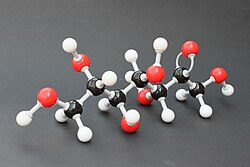 | |
 | |
| Names | |
|---|---|
| IUPAC name d-manno-Hept-2-ulose | |
| Identifiers | |
3D model (JSmol) | |
| ChemSpider | |
| ECHA InfoCard | 100.020.723 |
PubChem CID | |
| UNII | |
CompTox Dashboard (EPA) | |
| |
| |
| Properties | |
| C7H14O7 | |
| Molar mass | 210.182 g·mol−1 |
| Density | 1.7 g cm−3 |
Except where otherwise noted, data are given for materials in their standard state (at 25 °C [77 °F], 100 kPa). | |
Mannoheptulose is a heptose, a monosaccharide with seven carbon atoms, and a ketose, with the characteristic carbonyl group of the carbohydrate present on a secondary carbon (functioning as a ketone group). The sugar alcohol form of mannoheptulose is known as perseitol. [1]